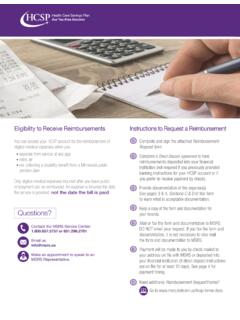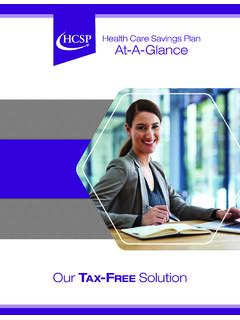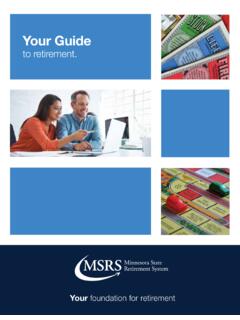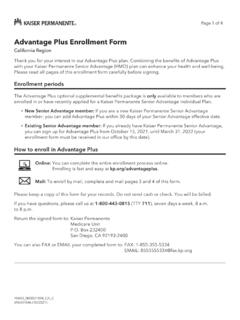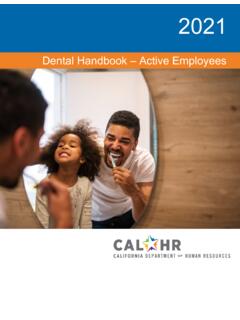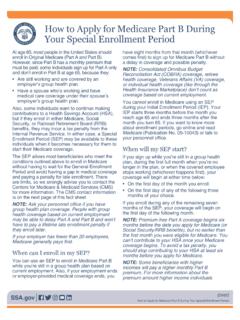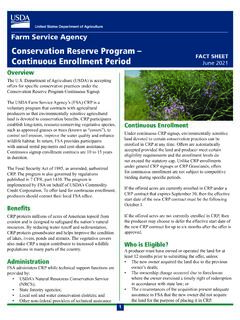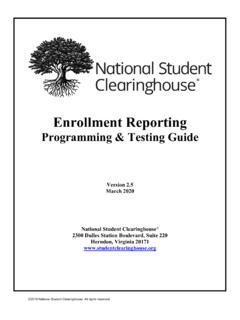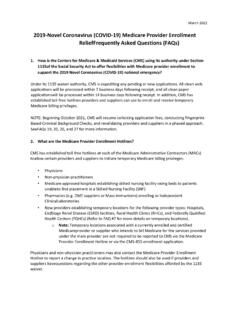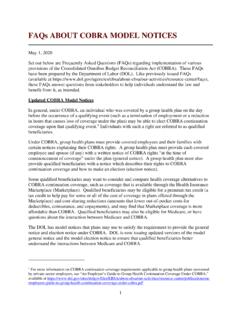Transcription of Plan Now Brochure
1 Enroll Today Plan Your Financial Future Plan Now for Your Financial Future Your retirement income will likely come from supplement retirement income from your your public pension benefit, Social Security Minnesota public pension and Social Security and personal savings. The Minnesota Deferred benefits. The MNDCP offers planning tools Compensation Plan (MNDCP) can help! and investment options that may help you take The MNDCP is a voluntary savings plan intended positive steps toward achieving your desired for long-term investing for retirement. Enrolling retirement lifestyle. in the MNDCP is a smart and easy way to Will your pension and Social Security benefits be enough or will you PERSONAL SOCIAL. SAVINGS SECURITY. need to rely on personal savings accounts? PENSION. BENEFIT. 2|. 5 Reasons to Enroll in the MNDCP. 1. Convenience Contributions are 4. Investing Flexibility You have the automatically deducted from your paycheck flexibility to select from a wide variety to make saving for your future a priority by of investment options within the plan.
2 Paying yourself first. Increase, decrease or stop your contribution amount at 5. Tax Savings If you make pre-tax any time. contributions, you don't pay federal or state income taxes until you take a 2. No IRS Tax Penalty The 10% federal withdrawal from your account. This means early withdrawal penalty typically assessed you can actually lower the amount of on withdrawals made before age 59 does current income taxes you pay each pay not apply to 457(b) plans (like the MNDCP). period. If you make after-tax contributions, The penalty does apply to withdrawals you pay federal and state income taxes attributed to assets rolled in from other now but pay no income taxes when you types of retirement savings plans ( 401(k), withdraw from your 403(b) or Traditional IRAs). Withdrawals may Tax-free as long as your MNDCP Roth Account was 1 . be subject to ordinary income tax. first funded more than 5 years ago AND you are age 59 or older at the time of withdrawal (or upon your disability or death).
3 3. Matching Dollars Most State employees have a match through their union. Non-State employers may also match a portion of your contributions. Check with your employer for details. |3. 1 De ci de h o w m u c h to save each pay per iod. Set a Savings Goal - Aim for 15%. Consider aiming high. Retirement professionals recommend saving at least 15% of your salary each This amount may seem like a lot, but it combines all of your retirement savings contributions 2. including those to your pension plan and voluntary savings accounts. Keep in mind, you can change your MNDCP contribution amount at any time. xample: If your annual pension contribution is 6% of your base salary, then a E. reasonable contribution to your MNDCP account might be 9%. For someone making $45,000 a year, that's $156 per pay period. 6% Pension Savings What does this mean to you? + Gross Salary: $45,000/year 3 9% Personal Savings 9% Annual MNDCP Savings: That's $156 per pay period $4,050/year FOR ILLUSTRATIVE PURPOSES ONLY.
4 The amount of savings you contribute depends on your income and pension savings rates. The calculation shown reflects how much =. someone could save if they earn a gross salary of $45,000. 15% Savings Goal per year and contributed 9% of their earnings to a defined contribution account over 26 pay periods. Center for Retirement Research at Boston College, 2014. 2 . Stanford Center of Longevity, 2018. 4. Try the Interactive Retirement Calculator Use our interactive calculator to determine how much retirement income you will need from personal savings to supplement your pension and Social Security benefits. 4|. Start Saving Early Saving early in life is important because of the power of compounding. Compounding is the ability of your contributions to generate earnings, which are then reinvested to generate their own earnings. In other words, compounding can generate earnings from previous earnings. The more time you have to save and the longer your contributions stay invested, the more opportunity you have for potential growth.
5 Example: This comparison shows the power of compounding. Sara's investments generate a larger account balance because she started saving ten years earlier than Mark. START $ STOP. SAVING SAVING. AGE 25 3K PER. YEAR. AGE 65 = $. 501,365. SARA. START $$ STOP. SAVING SAVING. AGE 35 3K PER. YEAR. AGE 65 = $. 252,634. MARK. FOR ILLUSTRATIVE PURPOSES ONLY. This hypothetical illustration is not intended as a projection or prediction of future investment results, nor is it intended as financial planning or advice. This example assumes $3,000 per year contributions at 6% annual rate of return and reinvestment of earnings with no withdrawals. Actual rates of return may vary. The illustration does not reflect any associated charges, expenses or fees. The tax-deferred accumulation shown would be reduced if these fees had been deducted. |5. 2 De termine w h e t h e r to con tr ibute pr e-tax o r Ro t h after-tax dollar s or both . What's the Difference?
6 All Minnesota public employers can offer MNDCP pre-tax savings. State of Minnesota employees are able to contribute to both Pre-Tax and Roth After-Tax dollars. Other Minnesota public employers may also offer the MNDCP Roth. Ask your employer if they have adopted the MNDCP Roth. 3. Contributions Pre-Tax Savings Pay no income taxes Roth After-Tax Savings Pay income taxes Can reduce your current Subject to federal, state, and local taxable income (where applicable) income taxes Earnings No income tax until withdrawn Tax-free* *T. ax-free as long as your MNDCP. Roth account was first funded Withdrawals Subject to federal, state, and local Tax-free* more than 5 years ago AND you (where applicable) income taxes are age 59 or older at the time of withdrawal (or upon your disability or death). Who Employees who: Employees who: Benefits? Expect to be in a lower Expect to be in a higher tax bracket 4. tax bracket later in life later in life Want to lower current Are in a low tax bracket today or have income taxes other large tax deductions Want tax-free withdrawals later in life Want the option of not taking required withdrawals at age 72 (if you roll over to a Roth IRA).
7 Want to save after-tax dollars in a Roth IRA but earnings exceed the Roth IRA. income limitations NOTE: Please review your specific circumstances with your tax or financial advisor Try the MSRS Roth Decision Tree online The interactive Roth decision tree may help you determine which savings route might be best for you. 6|. S e lect 3 h o w y ou w ant to in vest your con tr ibutions a m o n g th e in vestment options available in t h e M N DCP. What Kind of Investor Are You? Before you jump in and start choosing investments, spend some time thinking about your level of financial knowledge. 4. Are you a HANDS-OFF investor? Are you a HANDS-ON investor? I am not familiar with investment I am a knowledgeable investor terminology and have little understanding who could properly manage my of how to invest. I don't want to spend investments. I am comfortable making sure my investment portfolio has the right my time following every twist and turn mix of stocks and bonds or fixed income of the financial markets and making investments.
8 I know how to ensure sure my investment portfolio is my investment portfolio is properly diversified. properly diversified. Simplify investing with a Choose your own Target Retirement Fund investment options See pages 8-9 See pages 10-11. for more information. for more information. Carefully consider the investment option's objectives, risks, fees and expenses. Call or visit for a prospectus, summary prospectus and disclosure document as available, containing this information. Read them carefully before investing. |7. HANDS. HANDS-OFFOFF. Investor Investor Consider investing in a Minnesota Target Retirement Fund if you: Are not sure about how to build an investment portfolio Are unable to spend the time managing your investments Prefer a simplified, less involved approach to investing How Target Retirement Funds Work A MN Target Retirement Fund offers a diversified mix of stocks and bonds or fixed income investments. The funds are generally designed for investors expecting to retire around the year indicated in the fund's name.
9 A professional money manager selects and manages the right mix of investments based on the target date of the fund. Over time, each MN Target Retirement Fund's asset allocation becomes more conservative as the target date nears. The date in the fund name is the approximate date when the investor plans to start withdrawing their money (which is assumed to be at age 65). This reflects the need for reduced investment risk as the target date approaches. Typically at the end of a working career, investors reduce their investment risk by investing more conservatively in order to preserve their principal account balance. An investment in a Target Retirement Fund is not guaranteed at any time, including on or after the target date. MN Target Retirement Funds 2065 2060 2055 2050 2045 2040 2035 2030 2025 Income 100%. 80%. 60%. 40%. 20%. 0%. 45 40 35 30 25 20 15 10 5 5. Years to Retirement Date Retirement Date Stock investments Bond or fixed income investments The example shown is for illustrative purposes only.
10 The allocation will vary depending on the Target Retirement Funds' anticipated retirement date. Asset allocation investment options are subject to the risks of the underlying funds, which can be a mix of stocks/stock funds and bonds/bond funds. 8|. Here's What You Need To Do 1. Consider a MN Target Retirement Fund closest to the year you expect to begin taking withdrawals from your account. Funds with longer time horizons, such as the 2050 2065 funds, take on more risk by investing in stock funds to pursue growth. Funds with shorter time horizons, such as the 2025 2035 funds, take on less risk by investing more in bond funds or fixed income investments to preserve principal and target more income since the anticipated target retirement date is closer. 2. Review your investment at least annually and make planning and saving for your future a part of your life. Learn About the MN Target Retirement Funds Read more about the MN Target Retirement Funds, watch a short video, take an interactive lesson or view the detailed asset allocation of each fund online.
